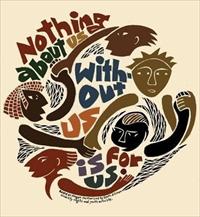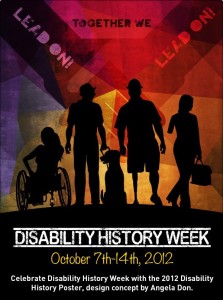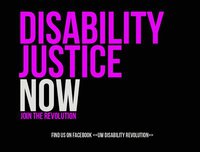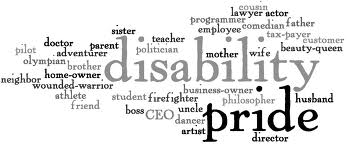Staring But Not Seeing: A Review of Seeing a Color-Blind Future: The Paradox of Race by Patricia Williams
Rachel Cohen-Rottenberg
Union Institute & University
Fall-Winter semester, 2012-2013
In her 1997 book, Seeing a Color-Blind Future: The Paradox of Race, Patricia Williams reflects upon the contradiction between our cultural insistence that color does not matter and the material reality of a world in which the construction of race has everything to do with one’s social, political, and economic experience. As I meditated on Williams’ words about the social construct and experience of race, I found myself noticing parallels to the social construct and experience of disability. While Williams does not include disability as a category of critical analysis, and while it would be appropriative to suggest that the experiences of race and disability are exactly the same, it is fair to say that similar issues come into play: the call to seeing the person, not the physical difference; the ways in which minority status is visible for critique, while the perspective of the majority becomes “natural” and fades into the background; the imperative to “pass”; the invitation to speak to one’s minority experience only for the benefit of those in the majority; the experience of being stared at but not seen clearly; and the necessity of battling against “scientific” representations that have little to do with lived experience. Unfortunately, while Williams protests the ways in which people can use one form of prejudice to argue against another, her analysis is marred by the fact that she uses pejorative disability metaphors in the service of her arguments against the insidious nature of racism.
An African-American professor of law at Columbia University and the author of the column “Diary of a Mad Law Professor” for The Nation, Williams is a prolific writer who has spent over 20 years tackling questions of social justice, race, ethnicity, class, and gender. She begins her book, however, with a personal story. She describes an incident at her son’s nursery school — an incident that derived from his white teachers’ well-intentioned imperative to be “color-blind,” but that ended up erasing the nature of her son’s racial experience. For most of his nursery school year, Williams tells us, his teachers believed that her son was color-blind. When asked what color the grass was, for example, he would respond that he either didn’t know or that it didn’t matter. After taking him to have his eyes examined and finding that he could see color perfectly well, Williams began to investigate why he was refusing to identify it (Williams 1997, 3). She learned that some of the children at his predominantly white school had been fighting about whether black people could be the “good guys” in playtime scenarios, and that the teachers had insisted that “it doesn’t matter…whether you’re black or white or red or green or blue” (Williams 1997, 3). She interpreted her son’s extreme refusal to identify color as an index of his anxiety that the teachers’ words would a) erase his own experience of color and b) deny his truth about the ways in which color matters in his relationships with others (Williams 1997, 4).
To put the imperative toward color-blindness another way: his teachers were telling the class to “see the person, not the color” in the same way that some in the disability community encourage able-bodied people to “see the person, not the disability” (Disability and Representation, 2012). In both cases, the imperative to see past the physical attribute, the insistence that the physical attribute does not matter, and the attempt to reach across difference by disregarding it derive from a desire to bring greater harmony to a world of injustice. The problem in both cases, of course, is that race and disability matter in that they are both social constructs that determine experience. Instead of taking a shortcut around the fact of race, Williams believes, we need to engage the experience of race in our culture in all of its manifestations (Williams 1997, 4-5). I would argue that exactly the same is true for disability. Until disability matters, not just as an indicator of personal experience, but also as a civil rights issue in which unjust social relations result in specific types of personal experience, there can be no significant progress toward the day when disability becomes a signifier of difference rather than a symbol of stigma and oppression.
One of the reasons, perhaps, that people rush to deny race and disability is that whiteness and normalcy are themselves invisible. Williams draws from whiteness theory when she writes that whiteness is an unmarked, de-racialized category; our culture does not tend to see whiteness as a race at all (Williams 2007, 6-7). Phil Smith extrapolates from whiteness theory to posit normal theory; for him, normalcy is analogous to whiteness in that it is simply an uncritiqued given and is considered “natural” (Smith 2004, 13). Perhaps, for those who are white and able-bodied, the desire to erase race and disability derives from a misplaced attempt to level the playing field. Perhaps people who insist that we “see the person, not the difference” are resting their view on the assumption that, because whiteness and normalcy are invisible, then race and disability should be invisible, too. Of course, the solution is not to make race and disability invisible, but to make whiteness and normalcy visible as categories of analysis. Until then, the invisibility of whiteness and normalcy will place people of color and disabled people in a realm apart. Williams writes that the invisibility of whiteness “permits whites to entertain the notion that race lives ‘over there’ on the other side of the tracks, in black bodies and inner-city neighborhoods, in a dark netherworld where whites are not involved” (Williams 1997, 7). As is the case with race, our cultural attitude toward disability is that it happens to someone else — someone who lives in a world apart, segregated from view (Murphy 1990, 110-111).
For both people of color and people with disabilities, this impetus toward invisibility takes the shape of pressure to “pass” so as not to intrude one’s difference upon the majority. Williams recounts the experience of her light-skinned cousin who could pass for white but identified herself in college as a member of the black law students’ association (Williams 1997, 53-54). When one of her professors found out that she had “outed” herself, Williams writes, he “grew agitated, annoyed, even confrontational”:
Why would she do such a thing, he wanted to know; why would she ‘label’ herself when she was so light-skinned and could so easily pass for white? My cousin was struck by how offended he was; he seemed to be implying that she had a obligation or a duty to pass and that her failure to do so was both impolitic and impolite. (Williams 1997, 54)
An analogous imperative to pass is the lot of disabled people who are able to hide their disabilities, as evidenced by Tobin Siebers’ remark that people with disabilities “must try to be as able-bodied as possible all the time” (Siebers 2011, 10). After reading Williams’ story about her cousin’s experience, I asked my circle of disabled friends whether anyone had had a similar experience about passing as nondisabled. A number of people had stories to tell. One autistic woman described her husband’s discomfort at her wearing bright yellow noise-blocking headphones and his worry that she was “disadvantaging” herself by choosing not to pass (Personal communication, 2012). Another autistic woman said that she had been accused of being impolite for not passing; after telling someone that her senses were overwhelmed and that she needed to find a quiet spot to recharge, the other person insisted that she continue passing, and chided her by saying “Lisa, you may have Aspergers, but you are intelligent enough to not act autistic” (Personal communication, 2012).
As a result of the cultural imperative to see race and disability as invisible, both are subject to what Williams calls “the forbidden gaze” (Williams 1997, 9). Children have a natural curiosity about difference (Brown 2010, 183) and, while our culture teaches them not to stare at non-normative people, it does not teach them how to engage difference (Williams 1997, 9). Because an interest in difference is both natural and culturally forbidden, people of color and disabled people find themselves in the paradoxical position of having to expose the nature of their experience for the use of others, right up until the point that their experience challenges the comfort of those doing the asking. People of color, Williams notes, “are ground down by the pendular stresses of having to explain what it feels like to be You … or, alternatively, placed in a kind of conversational quarantine of muteness” (Williams 1997, 9). Disabled people, too, find themselves in a similar quandary: they are either subject to questions from strangers about how they came to be disabled (Garland-Thomson 2000, 334) or they are ignored altogether (Murphy 1990, 118). In both cases, the center of gravity is the majority person. Minority people either perform for the majority person’s benefit, or they need to be quiet.
Interestingly enough, for both people of color and disabled people, the “forbidden gaze” turns into its opposite: intrusive staring. Williams refers to this propensity to stare as “racial voyeurism” (Williams 1997, 17). In one example among many, she describes the way in which tour buses in New York City bring tourists to black churches in order to “see the show” (Williams 1997, 22). Four hundred tourists arrive late, jockey for position for the best camera angles, photograph African Americans in prayer, and then disrupt the service by leaving en masse so as not to miss lunch (Williams 1997, 22-25). Williams considers the photographs a way of perpetuating the voyeuristic experience of watching “exotics”; she describes each picture as a “flat, dry, matted photographic relic to be spread out upon the coffee tables of faraway homes; the open-mouthed exotics, frozen in raucous song….” (Williams 1997, 25). Williams’ reflections on the voyeuristic nature of photography bring to mind Rosemarie Garland-Thomson’s statement that “photography authorizes staring” (Garland-Thomson 2002, 58) at disabled people, including those whom nondisabled people consider “wondrous” (Garland-Thomson 2002, 59-61) or “exotic” (Garland-Thomson 2002, 59). Through the eye of the camera, apparently, one can stare and circumvent the stricture against doing so.
And yet for all of this voyeurism, majority people often cannot clearly see the experience of race and disability at all. Williams recounts the discomfort of a colleague who was the only African-American attorney at a business luncheon where the waitstaff was entirely African-American. When the attorney mentioned to her white colleagues how uncomfortable she felt sitting among white professionals while being waited on by other people of color, her colleagues responded with profuse apologies for their choice of venue, all the while making it clear that they could not see the class barriers and social discomfort that were so painfully apparent to her (Williams 1997, 26-27). Siebers makes a similar observation about the experience of disabled people perceiving an architectural or social barrier that able-bodied people cannot see: “When we come to a barrier, we realize that our perception of the world does not conform to theirs, although they rarely have this realization. This difference in perception is a social barrier equal to or greater than any physical barrier…” (Siebers 2011, 51). In both cases, people in the minority are vividly aware of a core feature of their experience that is utterly invisible to those in the majority.
For both people of color and disabled people, the experience of not being seen properly sometimes takes the form of distorted representations in the guise of science — representations that rest on an ignorance of the daily lives and experiences of the people under study. Williams laments the way in which studies setting out to prove the genetic inferiority of black people periodically surface (Williams 1997, 51). Not only are the studies prejudicial, Williams notes, but they are also difficult to argue against; because they dress themselves up in the language of science and quantitative research, any rebuttal, in order to appear credible, must wear the same garb:
One of the great difficulties of pseudo-science is that it is so hard to refute just by saying it isn’t so… Black people find themselves responding endlessly to such studies before we can be heard on any other subject; we must credentialize ourselves as number-crunching social scientists quickly in order to be seen as even minimally intelligent… And it makes anyone who knows the great messy, unprovable contrary, who knows the indecipherable complexity of black or white people, who knows the reality and the potential of all humanity — us silly egalitarians — it makes us unintelligent, uninformed, powerless, and naïve. (Williams 1997, 49-50)
As Williams asserts, appeals to experience simply do not have a suitable degree of authority to counter anything that poses as science. Her analysis here reminds me of the charge of narcissism leveled at disabled people — the accusation that disability automatically renders one narcissistic — which is supposedly supported by the “science” of psychological research (Siebers 2011, 38-40). The parallel between racist pseudo-science and the pathologization of disability is telling, as is the difficulty of arguing against the “science” by bringing to bear experience that is not quantifiable. How does one use charts and graphs to prove empathy, or interest in others, or socially imposed suffering? How does one use quantitative measures to prove more than a small fraction of intelligence, talent, or insight?
Despite the fact that people of color and people with disabilities experience similar systems of oppressive representation, Williams does not pose disability as a critical category in Seeing a Color-Blind Future. She focuses on the intersections of race, ethnicity, gender, and class, and she notes the ways in which one form of prejudice is sometimes brought to bear in order to fight another; she calls this phenomenon “battling biases” (Williams 1997, 32). As an example of this conflict, she cites her experience of watching a counter person accuse a homeless customer of misogyny as a cover for her own class prejudice against him (Williams 1997, 31-32), and she concludes that this “revolving door of revulsions” is one of the ways in which prejudice remains entrenched (Williams 1997, 32).
Ironically enough, though, Williams engages in “battling biases” herself, using pejorative disability metaphors in order to analyze ways to break through other forms of prejudice. For example, she writes that “the eradication of prejudice, the reconciling of tensions across racial, ethnic, cultural, and religious lines, depends upon eradicating the little blindnesses, not just the big” (Williams 1997, 61), using blindness as a metaphor for a systemic failure to perceive the issues with which minority people struggle. In the same paragraph, she uses paralysis as a pejorative, speaking of the “paralyzing anxiety of well-meaning ‘white guilt’” as a metaphor for recalcitrance and lack of progress on race relations (Williams 1997, 61). In fact, she speaks of her son being pathologized as color-blind for his racial experience (Williams 1997, 5), but she doesn’t seem to realize that disabled people are equally pathologized for our disability experience, and that she is helping to perpetuate that pathologizing impulse.
An understanding of the commonalities between the experience of race and the experience of disability might have helped Williams bring disability into critical focus as a category of oppression and illuminate the ways in which both people of color and disabled people must struggle against similar obstacles. She might have helped make clear that disability, like race, is not simply a question of bodily difference, but an expression of a political and social experience. If Williams had brought disability into her analysis, she might have come to see that disability, like race, is an issue of civil rights and that, rather than deflecting our gaze from it, we must fully engage it.
References
Brown, Lerita M. Coleman. “Stigma: An Enigma Demystified.” In The Disability Studies Reader, edited by Lennard J. Davis, 179-192. New York, NY: Routledge, 2010.
Disability and Representation. “The Problem with Person-First Language: What’s Wrong with This Picture?” http://www.disabilityandrepresentation.com/2012/05/30/the-problem-with-person-first-language-whats-wrong-with-this-picture/. May 30, 2012. Accessed May 30, 2012.
Garland-Thomson, Rosemarie. “Staring Back: Self-Representations of Disabled Performance Artists.” American Quarterly 52, no. 2 (Jun., 2000): 334-338. http://www.jstor.org/pss/30041845.
Garland-Thomson, Rosemarie. “The Politics of Staring: Visual Rhetorics of Disability in Popular Photography.” In Disability Studies: Enabling the Humanities, edited by Sharon L. Snyder, Brenda Jo Brueggemann, and Rosemarie Garland-Thomson, 56-75. New York, NY: Modern Language Association of America, 2002.
Murphy, Robert Francis. The Body Silent. New York, NY: W.W. Norton & Company, Inc., 1990.
Siebers, Tobin. Disability Theory. Ann Arbor, MI: University of Michigan Press, 2011.
Smith, Phil. “Whiteness, Normal Theory, and Disability Studies.” Disability Studies Quarterly 24, no. 2 (2004): 1-24. http://dsq-sds.org/article/view/491/668.
Williams, Patricia. Seeing a Color-Blind Future: The Paradox of Race. New York, NY: Farrar, Strauss, and Giroux, 1997.
© 2012 by Rachel Cohen-Rottenberg








